SUZUKI SWIFT 2000 1.G RG413 Service Workshop Manual
[x] Cancel search | Manufacturer: SUZUKI, Model Year: 2000, Model line: SWIFT, Model: SUZUKI SWIFT 2000 1.GPages: 698, PDF Size: 16.01 MB
Page 461 of 698
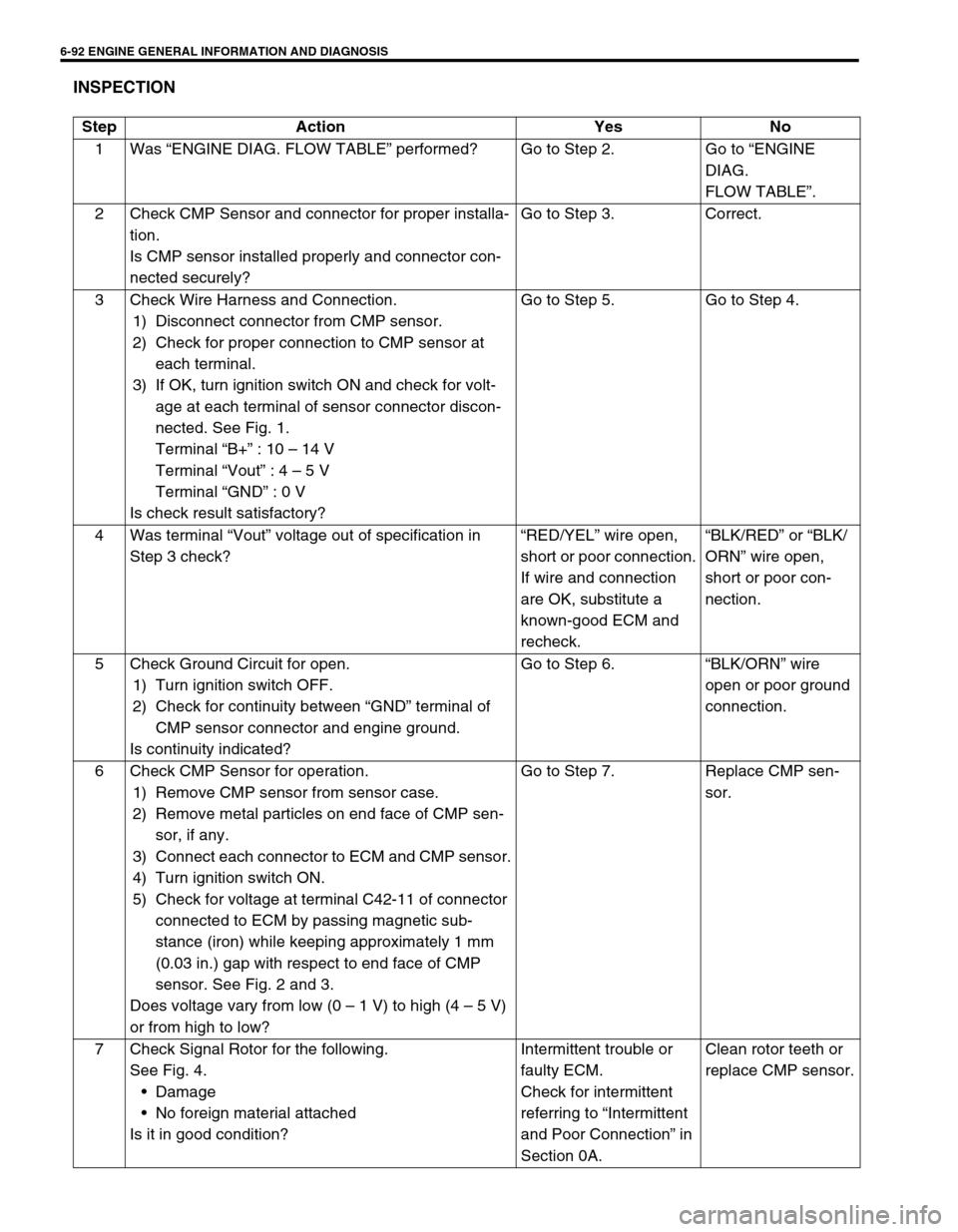
6-92 ENGINE GENERAL INFORMATION AND DIAGNOSIS
INSPECTION
Step Action Yes No
1Was “ENGINE DIAG. FLOW TABLE” performed? Go to Step 2. Go to “ENGINE
DIAG.
FLOW TABLE”.
2 Check CMP Sensor and connector for proper installa-
tion.
Is CMP sensor installed properly and connector con-
nected securely?Go to Step 3. Correct.
3 Check Wire Harness and Connection.
1) Disconnect connector from CMP sensor.
2) Check for proper connection to CMP sensor at
each terminal.
3) If OK, turn ignition switch ON and check for volt-
age at each terminal of sensor connector discon-
nected. See Fig. 1.
Terminal “B+” : 10 – 14 V
Terminal “Vout” : 4 – 5 V
Terminal “GND” : 0 V
Is check result satisfactory?Go to Step 5. Go to Step 4.
4Was terminal “Vout” voltage out of specification in
Step 3 check?“RED/YEL” wire open,
short or poor connection.
If wire and connection
are OK, substitute a
known-good ECM and
recheck.“BLK/RED” or “BLK/
ORN” wire open,
short or poor con-
nection.
5 Check Ground Circuit for open.
1) Turn ignition switch OFF.
2) Check for continuity between “GND” terminal of
CMP sensor connector and engine ground.
Is continuity indicated?Go to Step 6.“BLK/ORN” wire
open or poor ground
connection.
6 Check CMP Sensor for operation.
1) Remove CMP sensor from sensor case.
2) Remove metal particles on end face of CMP sen-
sor, if any.
3) Connect each connector to ECM and CMP sensor.
4) Turn ignition switch ON.
5) Check for voltage at terminal C42-11 of connector
connected to ECM by passing magnetic sub-
stance (iron) while keeping approximately 1 mm
(0.03 in.) gap with respect to end face of CMP
sensor. See Fig. 2 and 3.
Does voltage vary from low (0 – 1 V) to high (4 – 5 V)
or from high to low?Go to Step 7. Replace CMP sen-
sor.
7 Check Signal Rotor for the following.
See Fig. 4.
Damage
No foreign material attached
Is it in good condition?Intermittent trouble or
faulty ECM.
Check for intermittent
referring to “Intermittent
and Poor Connection” in
Section 0A.Clean rotor teeth or
replace CMP sensor.
Page 462 of 698
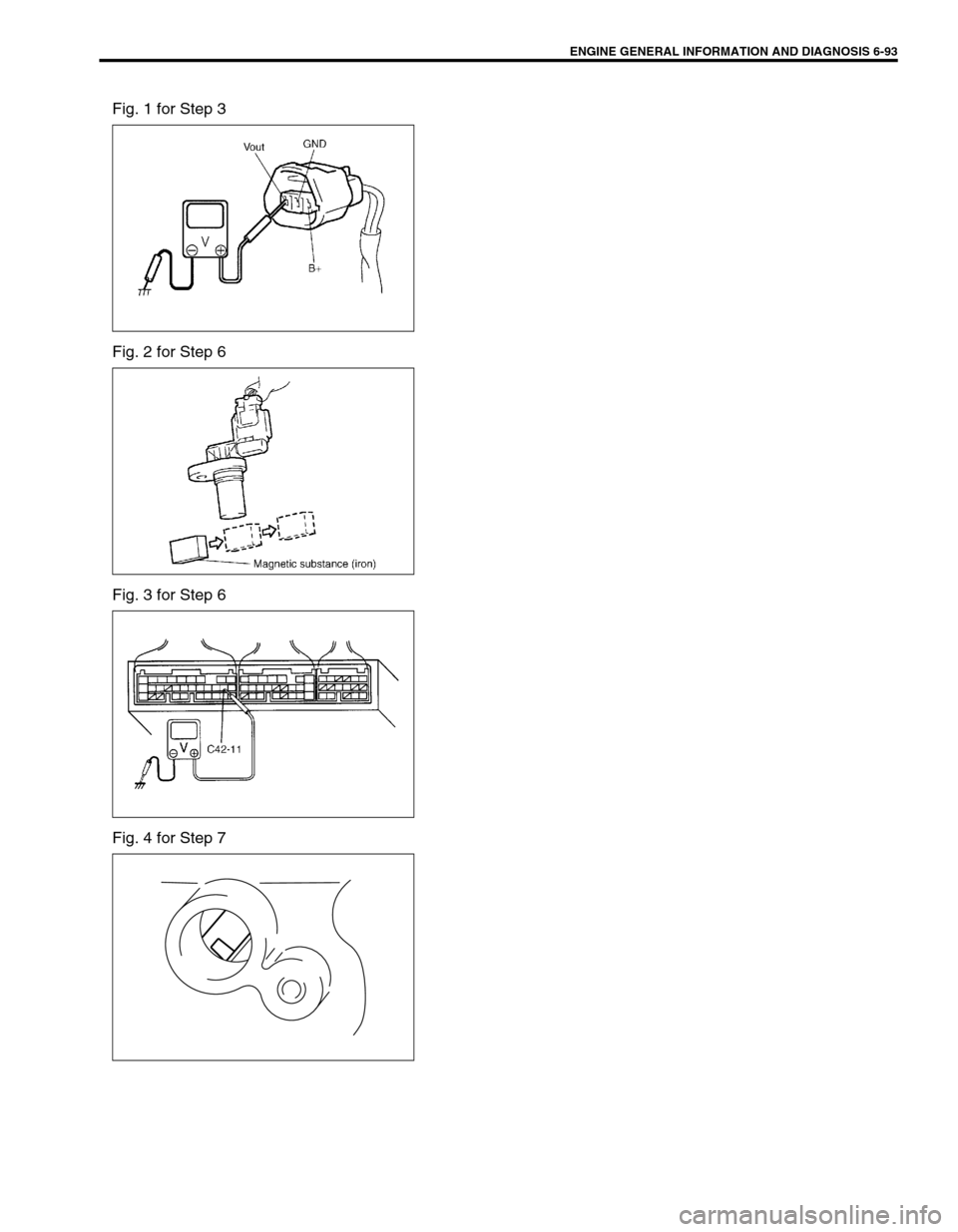
ENGINE GENERAL INFORMATION AND DIAGNOSIS 6-93
Fig. 1 for Step 3
Fig. 2 for Step 6
Fig. 3 for Step 6
Fig. 4 for Step 7
Page 463 of 698
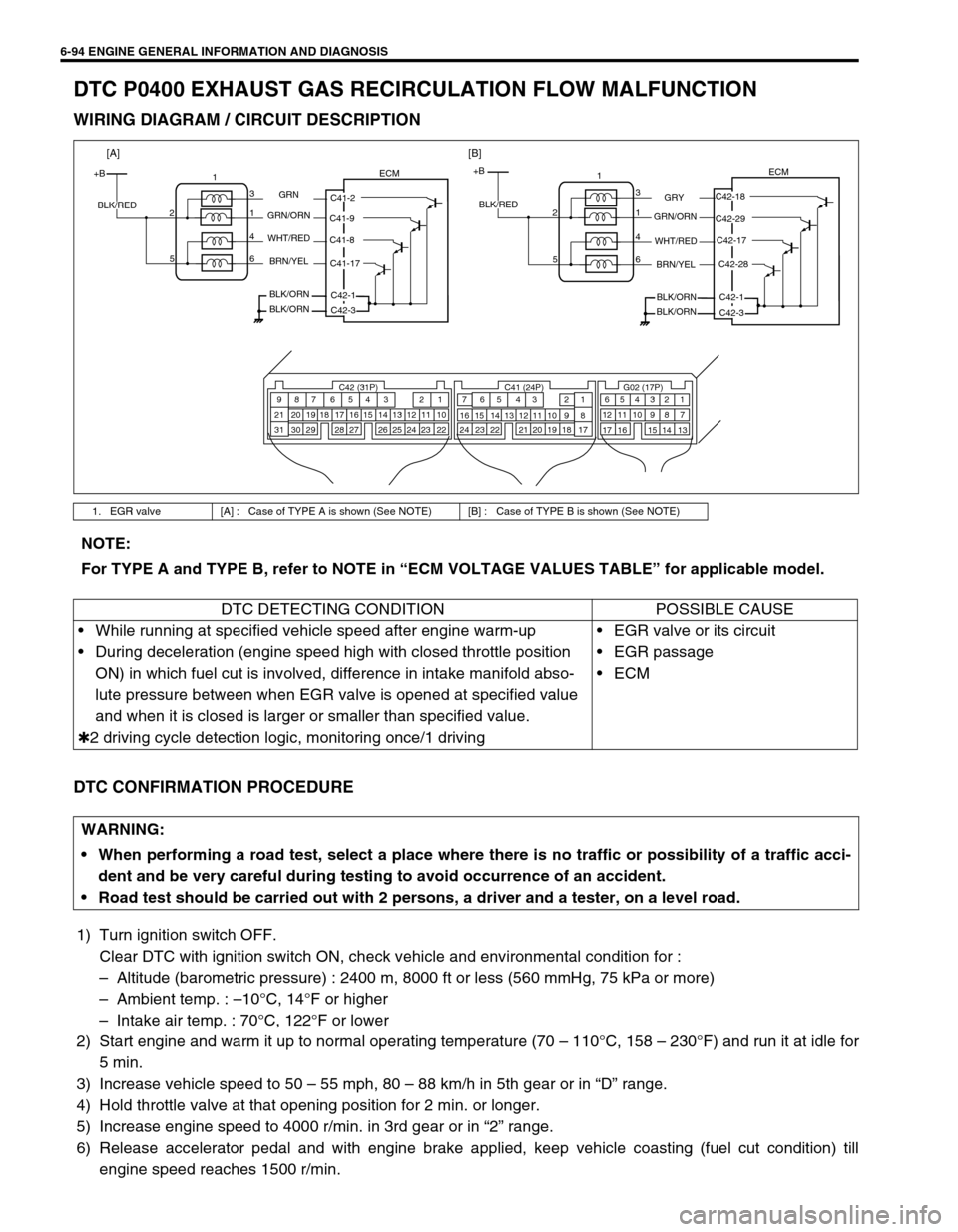
6-94 ENGINE GENERAL INFORMATION AND DIAGNOSIS
DTC P0400 EXHAUST GAS RECIRCULATION FLOW MALFUNCTION
WIRING DIAGRAM / CIRCUIT DESCRIPTION
DTC CONFIRMATION PROCEDURE
1) Turn ignition switch OFF.
Clear DTC with ignition switch ON, check vehicle and environmental condition for :
–Altitude (barometric pressure) : 2400 m, 8000 ft or less (560 mmHg, 75 kPa or more)
–Ambient temp. : –10°C, 14°F or higher
–Intake air temp. : 70°C, 122°F or lower
2) Start engine and warm it up to normal operating temperature (70 – 110°C, 158 – 230°F) and run it at idle for
5 min.
3) Increase vehicle speed to 50 – 55 mph, 80 – 88 km/h in 5th gear or in “D” range.
4) Hold throttle valve at that opening position for 2 min. or longer.
5) Increase engine speed to 4000 r/min. in 3rd gear or in “2” range.
6) Release accelerator pedal and with engine brake applied, keep vehicle coasting (fuel cut condition) till
engine speed reaches 1500 r/min.
1. EGR valve [A] : Case of TYPE A is shown (See NOTE) [B] : Case of TYPE B is shown (See NOTE)
C42 (31P) C41 (24P) G02 (17P)1 2 3 4 5 6 7 8 9
10 11 12 13 14 15 16 17 18 19 20 21
22 23 24 25 26 28 27 29 30 315 6
1 2 3 4 5 6 7
11 12
9 10 11 13 12 14 15 16
16 171 2
7 8
13 14 3 4
9 10
15 17 188
19 20 21 22 23 24
+BECM
C42-18
C42-29
C42-28 C42-17
C42-1
GRY
GRN/ORN
WHT/RED
C42-3 BRN/YEL
BLK/ORN
BLK/ORN BLK/RED1
3
1 2
4
6 5
+BECM
C41-2
C41-9
C41-17 C41-8
C42-1
GRN
GRN/ORN
WHT/RED
C42-3 BRN/YEL
BLK/ORN
BLK/ORN BLK/RED1
3
1 2
4
6 5
[A][B]
NOTE:
For TYPE A and TYPE B, refer to NOTE in “ECM VOLTAGE VALUES TABLE” for applicable model.
DTC DETECTING CONDITION POSSIBLE CAUSE
While running at specified vehicle speed after engine warm-up
During deceleration (engine speed high with closed throttle position
ON) in which fuel cut is involved, difference in intake manifold abso-
lute pressure between when EGR valve is opened at specified value
and when it is closed is larger or smaller than specified value.
✱2 driving cycle detection logic, monitoring once/1 drivingEGR valve or its circuit
EGR passage
ECM
WARNING:
When performing a road test, select a place where there is no traffic or possibility of a traffic acci-
dent and be very careful during testing to avoid occurrence of an accident.
Road test should be carried out with 2 persons, a driver and a tester, on a level road.
Page 464 of 698
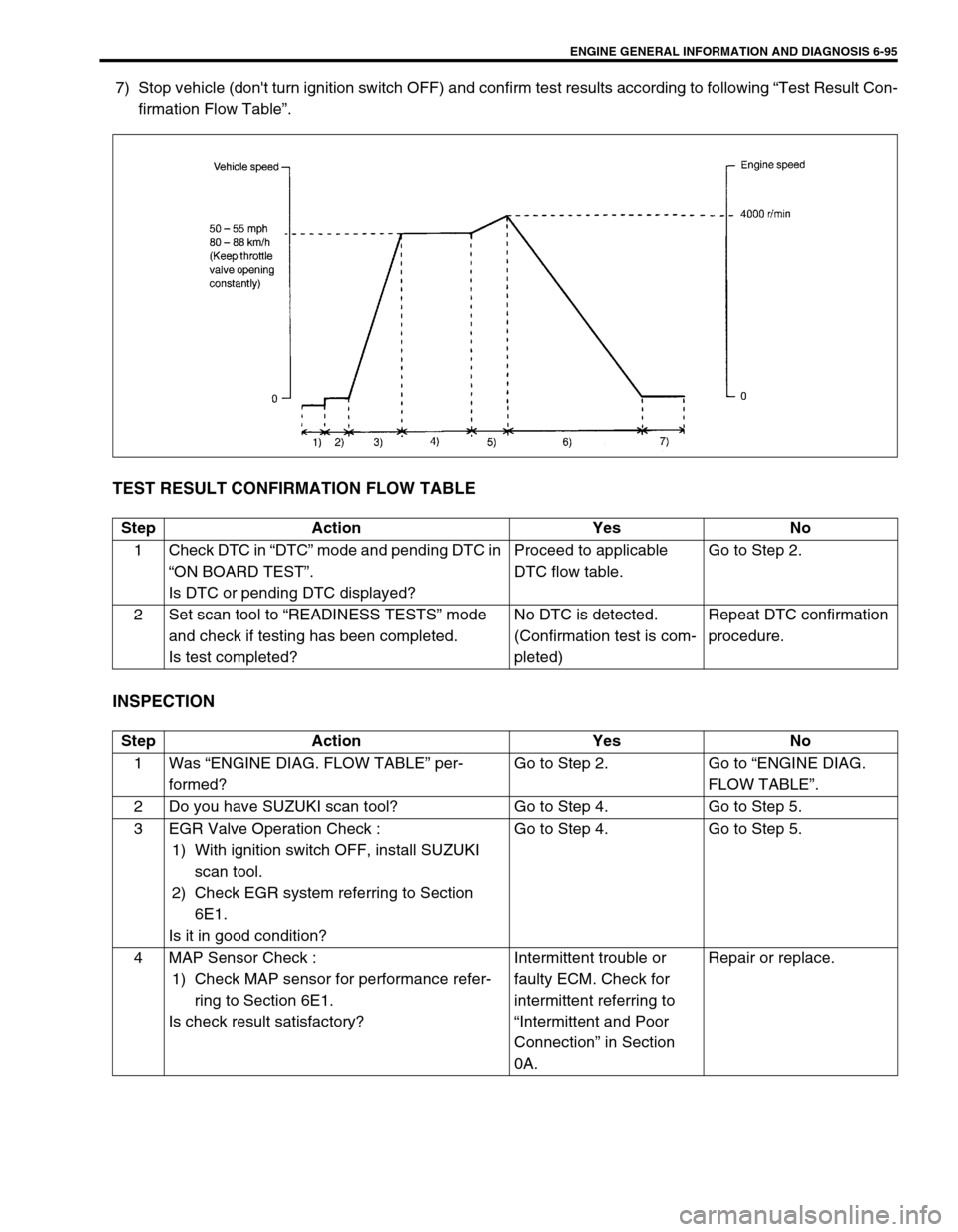
ENGINE GENERAL INFORMATION AND DIAGNOSIS 6-95
7) Stop vehicle (don't turn ignition switch OFF) and confirm test results according to following “Test Result Con-
firmation Flow Table”.
TEST RESULT CONFIRMATION FLOW TABLE
INSPECTION
Step Action Yes No
1Check DTC in “DTC” mode and pending DTC in
“ON BOARD TEST”.
Is DTC or pending DTC displayed?Proceed to applicable
DTC flow table.Go to Step 2.
2 Set scan tool to “READINESS TESTS” mode
and check if testing has been completed.
Is test completed?No DTC is detected.
(Confirmation test is com-
pleted)Repeat DTC confirmation
procedure.
Step Action Yes No
1Was “ENGINE DIAG. FLOW TABLE” per-
formed?Go to Step 2. Go to “ENGINE DIAG.
FLOW TABLE”.
2 Do you have SUZUKI scan tool? Go to Step 4. Go to Step 5.
3 EGR Valve Operation Check :
1) With ignition switch OFF, install SUZUKI
scan tool.
2) Check EGR system referring to Section
6E1.
Is it in good condition?Go to Step 4. Go to Step 5.
4 MAP Sensor Check :
1) Check MAP sensor for performance refer-
ring to Section 6E1.
Is check result satisfactory?Intermittent trouble or
faulty ECM. Check for
intermittent referring to
“Intermittent and Poor
Connection” in Section
0A.Repair or replace.
Page 465 of 698
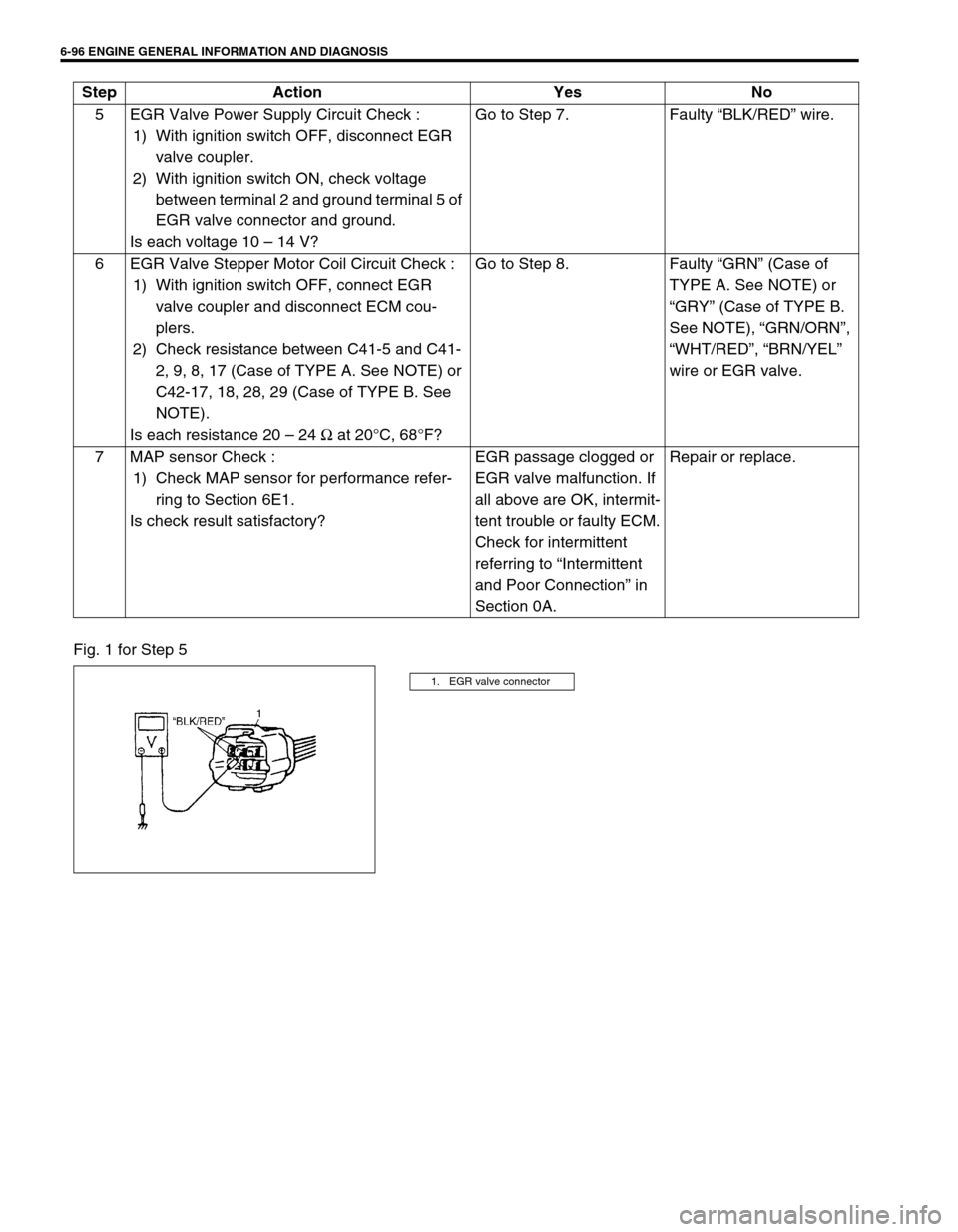
6-96 ENGINE GENERAL INFORMATION AND DIAGNOSIS
Fig. 1 for Step 55 EGR Valve Power Supply Circuit Check :
1) With ignition switch OFF, disconnect EGR
valve coupler.
2) With ignition switch ON, check voltage
between terminal 2 and ground terminal 5 of
EGR valve connector and ground.
Is each voltage 10 – 14 V?Go to Step 7. Faulty “BLK/RED” wire.
6 EGR Valve Stepper Motor Coil Circuit Check :
1) With ignition switch OFF, connect EGR
valve coupler and disconnect ECM cou-
plers.
2) Check resistance between C41-5 and C41-
2, 9, 8, 17 (Case of TYPE A. See NOTE) or
C42-17, 18, 28, 29 (Case of TYPE B. See
NOTE).
Is each resistance 20 – 24 Ω at 20°C, 68°F?Go to Step 8. Faulty “GRN” (Case of
TYPE A. See NOTE) or
“GRY” (Case of TYPE B.
See NOTE), “GRN/ORN”,
“WHT/RED”, “BRN/YEL”
wire or EGR valve.
7 MAP sensor Check :
1) Check MAP sensor for performance refer-
ring to Section 6E1.
Is check result satisfactory?EGR passage clogged or
EGR valve malfunction. If
all above are OK, intermit-
tent trouble or faulty ECM.
Check for intermittent
referring to “Intermittent
and Poor Connection” in
Section 0A.Repair or replace. Step Action Yes No
1. EGR valve connector
Page 466 of 698
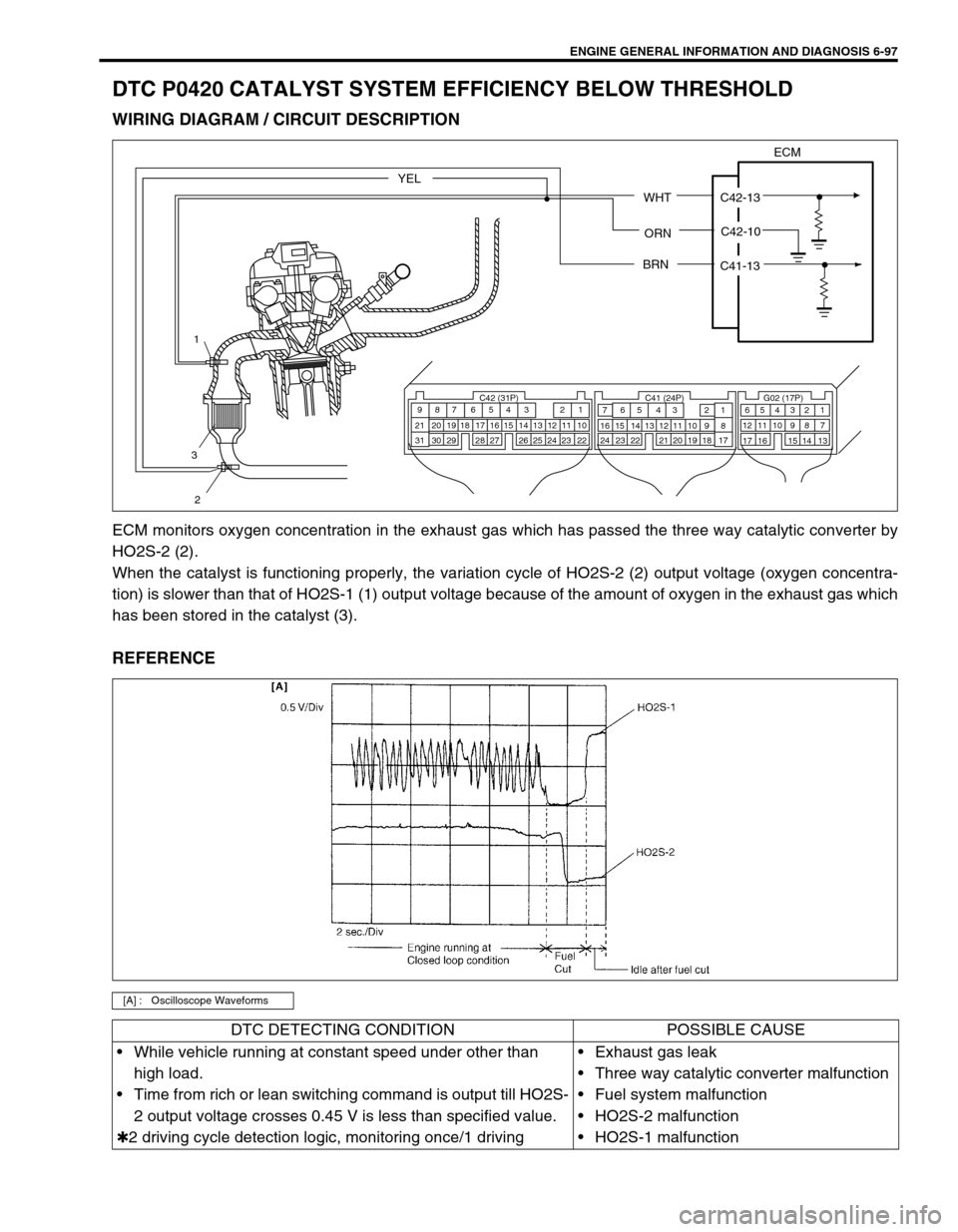
ENGINE GENERAL INFORMATION AND DIAGNOSIS 6-97
DTC P0420 CATALYST SYSTEM EFFICIENCY BELOW THRESHOLD
WIRING DIAGRAM / CIRCUIT DESCRIPTION
ECM monitors oxygen concentration in the exhaust gas which has passed the three way catalytic converter by
HO2S-2 (2).
When the catalyst is functioning properly, the variation cycle of HO2S-2 (2) output voltage (oxygen concentra-
tion) is slower than that of HO2S-1 (1) output voltage because of the amount of oxygen in the exhaust gas which
has been stored in the catalyst (3).
REFERENCE
[A] : Oscilloscope Waveforms
C42 (31P) C41 (24P) G02 (17P)1 2 3 4 5 6 7 8 9
10 11 12 13 14 15 16 17 18 19 20 21
22 23 24 25 26 28 27 29 30 315 6
1 2 3 4 5 6 7
11 12
9 10 11 13 12 14 15 16
16 171 2
7 8
13 14 3 4
9 10
15 17 188
19 20 21 22 23 24
1
2
3
ECM
WHT
ORNC42-10 C42-13
BRN
C41-13
YEL
DTC DETECTING CONDITION POSSIBLE CAUSE
While vehicle running at constant speed under other than
high load.
Time from rich or lean switching command is output till HO2S-
2 output voltage crosses 0.45 V is less than specified value.
✱2 driving cycle detection logic, monitoring once/1 drivingExhaust gas leak
Three way catalytic converter malfunction
Fuel system malfunction
HO2S-2 malfunction
HO2S-1 malfunction
Page 467 of 698
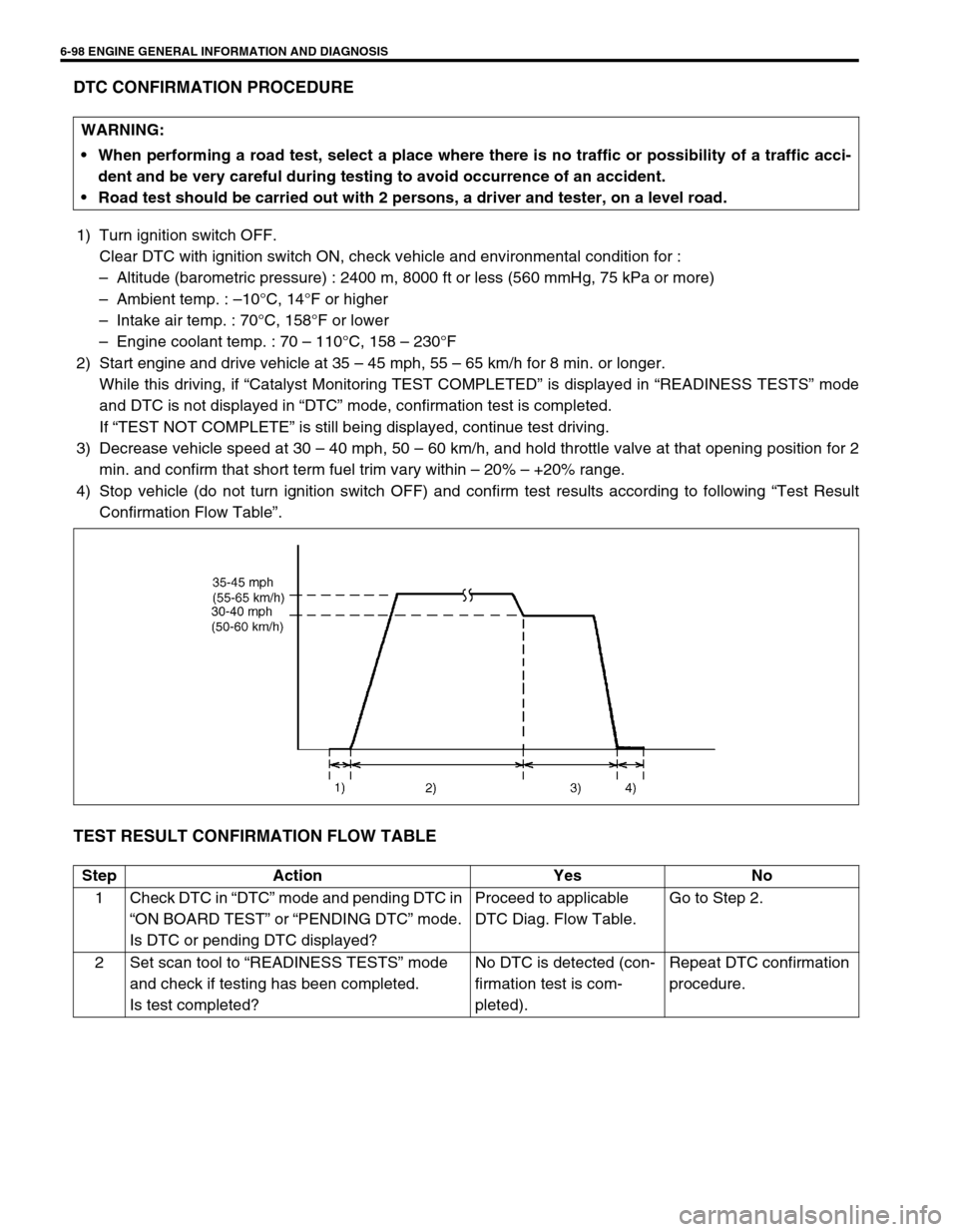
6-98 ENGINE GENERAL INFORMATION AND DIAGNOSIS
DTC CONFIRMATION PROCEDURE
1) Turn ignition switch OFF.
Clear DTC with ignition switch ON, check vehicle and environmental condition for :
–Altitude (barometric pressure) : 2400 m, 8000 ft or less (560 mmHg, 75 kPa or more)
–Ambient temp. : –10°C, 14°F or higher
–Intake air temp. : 70°C, 158°F or lower
–Engine coolant temp. : 70 – 110°C, 158 – 230°F
2) Start engine and drive vehicle at 35 – 45 mph, 55 – 65 km/h for 8 min. or longer.
While this driving, if “Catalyst Monitoring TEST COMPLETED” is displayed in “READINESS TESTS” mode
and DTC is not displayed in “DTC” mode, confirmation test is completed.
If “TEST NOT COMPLETE” is still being displayed, continue test driving.
3) Decrease vehicle speed at 30 – 40 mph, 50 – 60 km/h, and hold throttle valve at that opening position for 2
min. and confirm that short term fuel trim vary within – 20% – +20% range.
4) Stop vehicle (do not turn ignition switch OFF) and confirm test results according to following “Test Result
Confirmation Flow Table”.
TEST RESULT CONFIRMATION FLOW TABLE
WARNING:
When performing a road test, select a place where there is no traffic or possibility of a traffic acci-
dent and be very careful during testing to avoid occurrence of an accident.
Road test should be carried out with 2 persons, a driver and tester, on a level road.
Step Action Yes No
1 Check DTC in “DTC” mode and pending DTC in
“ON BOARD TEST” or “PENDING DTC” mode.
Is DTC or pending DTC displayed?Proceed to applicable
DTC Diag. Flow Table.Go to Step 2.
2 Set scan tool to “READINESS TESTS” mode
and check if testing has been completed.
Is test completed?No DTC is detected (con-
firmation test is com-
pleted).Repeat DTC confirmation
procedure.
Page 468 of 698
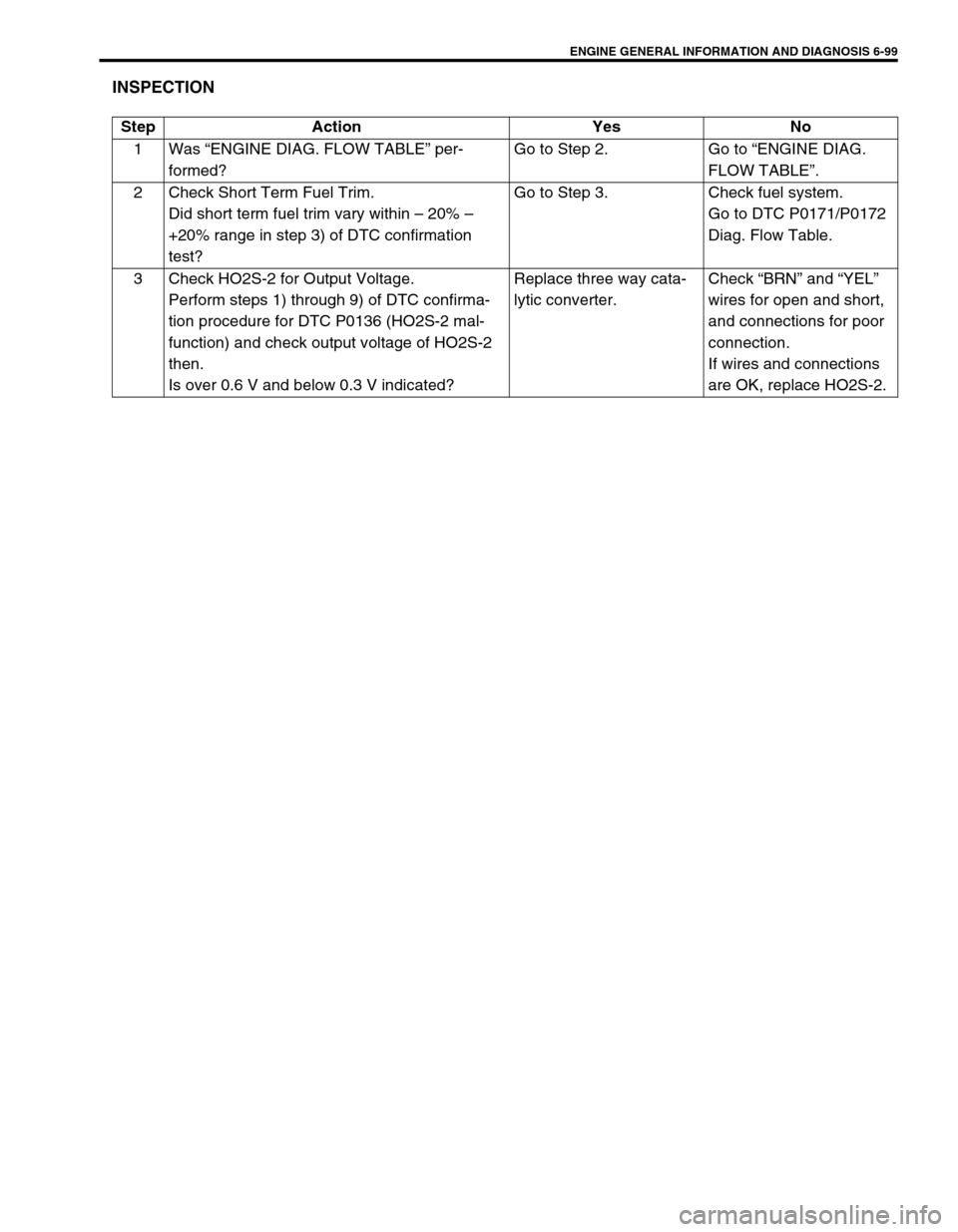
ENGINE GENERAL INFORMATION AND DIAGNOSIS 6-99
INSPECTION
Step Action Yes No
1Was “ENGINE DIAG. FLOW TABLE” per-
formed?Go to Step 2. Go to “ENGINE DIAG.
FLOW TABLE”.
2 Check Short Term Fuel Trim.
Did short term fuel trim vary within – 20% –
+20% range in step 3) of DTC confirmation
test?Go to Step 3. Check fuel system.
Go to DTC P0171/P0172
Diag. Flow Table.
3 Check HO2S-2 for Output Voltage.
Perform steps 1) through 9) of DTC confirma-
tion procedure for DTC P0136 (HO2S-2 mal-
function) and check output voltage of HO2S-2
then.
Is over 0.6 V and below 0.3 V indicated?Replace three way cata-
lytic converter.Check “BRN” and “YEL”
wires for open and short,
and connections for poor
connection.
If wires and connections
are OK, replace HO2S-2.
Page 469 of 698
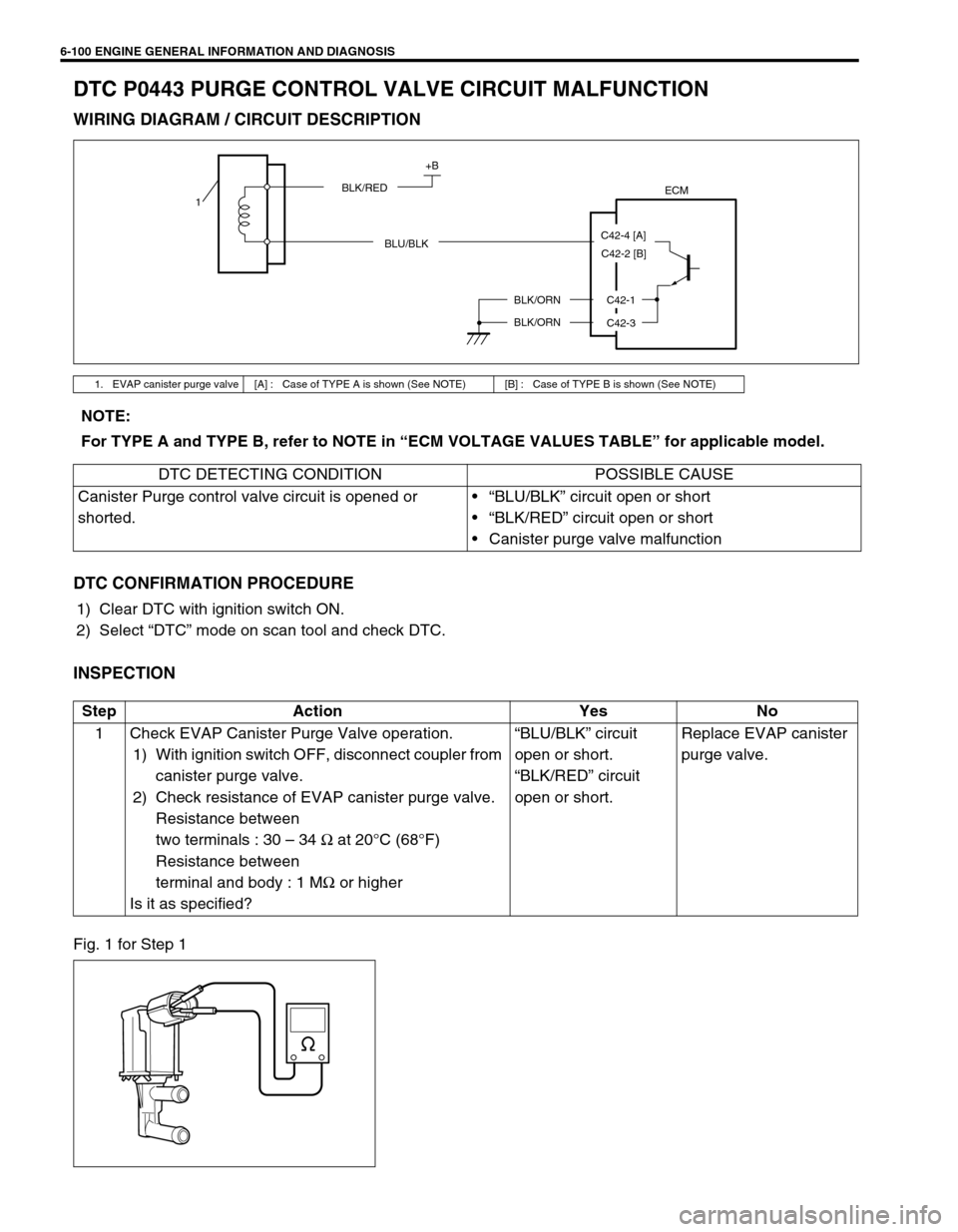
6-100 ENGINE GENERAL INFORMATION AND DIAGNOSIS
DTC P0443 PURGE CONTROL VALVE CIRCUIT MALFUNCTION
WIRING DIAGRAM / CIRCUIT DESCRIPTION
DTC CONFIRMATION PROCEDURE
1) Clear DTC with ignition switch ON.
2) Select “DTC” mode on scan tool and check DTC.
INSPECTION
Fig. 1 for Step 1
1. EVAP canister purge valve [A] : Case of TYPE A is shown (See NOTE) [B] : Case of TYPE B is shown (See NOTE)
ECM
+B
BLK/RED
BLU/BLK
BLK/ORN
BLK/ORNC42-1
C42-3
1
C42-4 [A]
C42-2 [B]
NOTE:
For TYPE A and TYPE B, refer to NOTE in “ECM VOLTAGE VALUES TABLE” for applicable model.
DTC DETECTING CONDITION POSSIBLE CAUSE
Canister Purge control valve circuit is opened or
shorted.“BLU/BLK” circuit open or short
“BLK/RED” circuit open or short
Canister purge valve malfunction
Step Action Yes No
1 Check EVAP Canister Purge Valve operation.
1) With ignition switch OFF, disconnect coupler from
canister purge valve.
2) Check resistance of EVAP canister purge valve.
Resistance between
two terminals : 30 – 34 Ω at 20°C (68°F)
Resistance between
terminal and body : 1 MΩ or higher
Is it as specified?“BLU/BLK” circuit
open or short.
“BLK/RED” circuit
open or short.Replace EVAP canister
purge valve.
Page 470 of 698
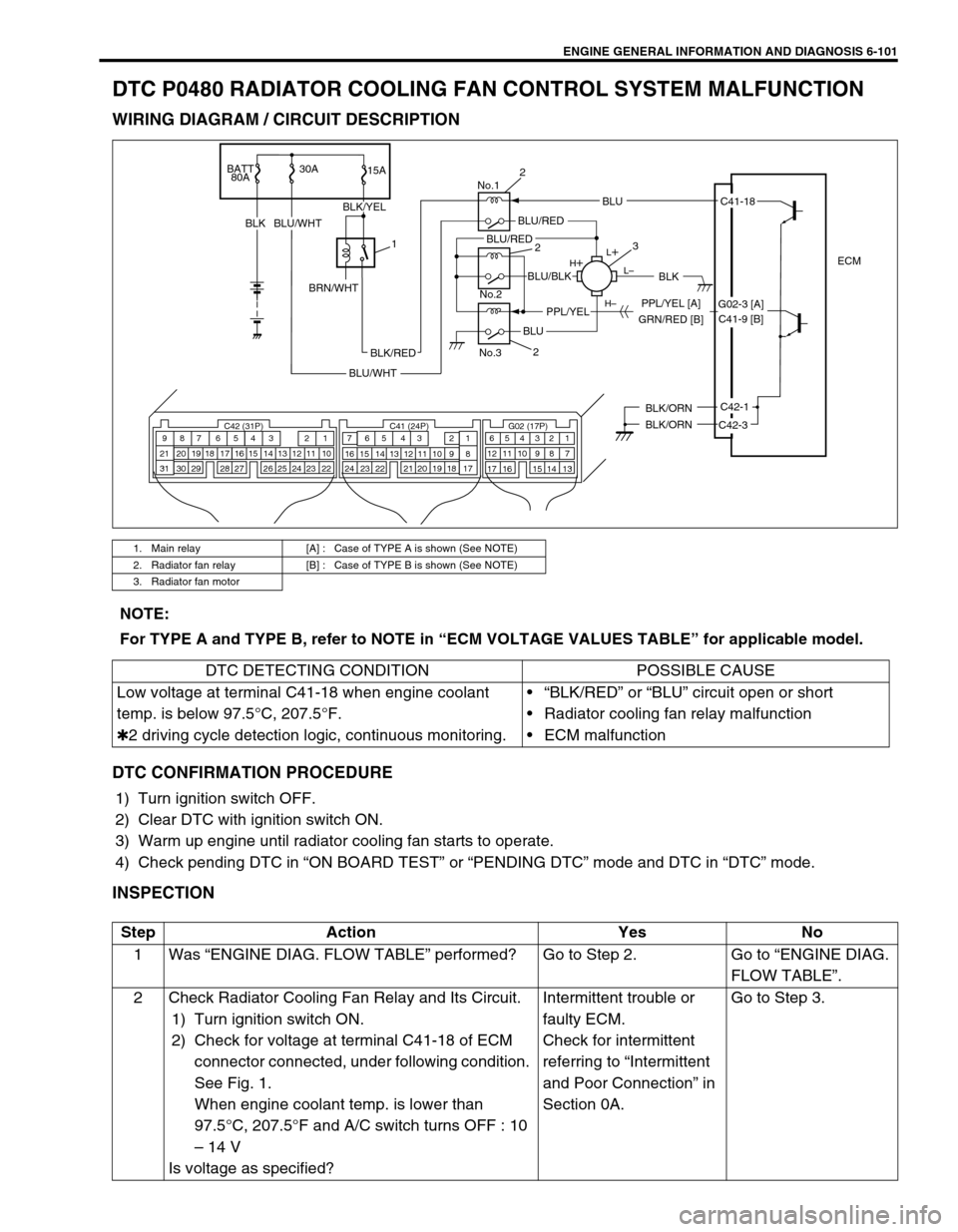
ENGINE GENERAL INFORMATION AND DIAGNOSIS 6-101
DTC P0480 RADIATOR COOLING FAN CONTROL SYSTEM MALFUNCTION
WIRING DIAGRAM / CIRCUIT DESCRIPTION
DTC CONFIRMATION PROCEDURE
1) Turn ignition switch OFF.
2) Clear DTC with ignition switch ON.
3) Warm up engine until radiator cooling fan starts to operate.
4) Check pending DTC in “ON BOARD TEST” or “PENDING DTC” mode and DTC in “DTC” mode.
INSPECTION
1. Main relay [A] : Case of TYPE A is shown (See NOTE)
2. Radiator fan relay [B] : Case of TYPE B is shown (See NOTE)
3. Radiator fan motor
BATT
80A30A
15A
BLKBLU/WHT
ECM
BLK/ORN
BLK/ORNC42-1
C42-3
L
L–
H– H
No.1
No.2
No.3
BLU
C42 (31P) C41 (24P) G02 (17P)1 2 3 4 5 6 7 8 9
10 11 12 13 14 15 16 17 18 19 20 21
22 23 24 25 26 28 27 29 30 315 6
1 2 3 4 5 6 7
11 12
9 10 11 13 12 14 15 16
16 171 2
7 8
13 14 3 4
9 10
15 17 188
19 20 21 22 23 24
C41-18
GRN/RED [B]PPL/YEL [A]
BLK/RED
BLU/WHT
BLU/RED
BLK
BLU
BLU/BLK
PPL/YEL
BLU/RED
BLK/YEL
1
BRN/WHT
2
3
2
2
G02-3 [A]
C41-9 [B]
NOTE:
For TYPE A and TYPE B, refer to NOTE in “ECM VOLTAGE VALUES TABLE” for applicable model.
DTC DETECTING CONDITION POSSIBLE CAUSE
Low voltage at terminal C41-18 when engine coolant
temp. is below 97.5°C, 207.5°F.
✱2 driving cycle detection logic, continuous monitoring.“BLK/RED” or “BLU” circuit open or short
Radiator cooling fan relay malfunction
ECM malfunction
Step Action Yes No
1Was “ENGINE DIAG. FLOW TABLE” performed? Go to Step 2. Go to “ENGINE DIAG.
FLOW TABLE”.
2 Check Radiator Cooling Fan Relay and Its Circuit.
1) Turn ignition switch ON.
2) Check for voltage at terminal C41-18 of ECM
connector connected, under following condition.
See Fig. 1.
When engine coolant temp. is lower than
97.5°C, 207.5°F and A/C switch turns OFF : 10
– 14 V
Is voltage as specified?Intermittent trouble or
faulty ECM.
Check for intermittent
referring to “Intermittent
and Poor Connection” in
Section 0A.Go to Step 3.